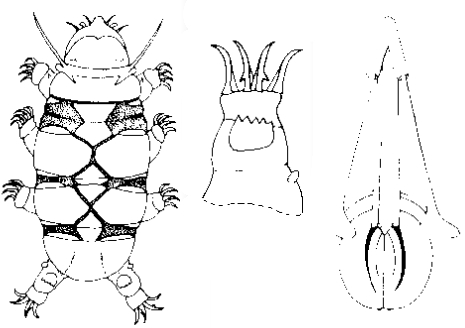From Ramazzotti & Maucci 1983 (tr. Beasley 1995): Median plates l, 2,3 divided transversely, so that total of 6 median plates visible.
From Kristensen 1987: “Unpigmented to rose coloured Echiniscidae with red eyes, short inflexible buccal tube, with CaCO3 encrusted stylet supports. All median plates 1,2,3 divided, without pseudosegmental plates, with small lateral intersegmental plate present. … Caudal plate without notching or indentation, but with two sutures of facets prsent in the same area as notching in the genus Echiniscus. … Leg appendages present on I and IV pair of legs. Only leg IV has sculptured leg plate with serrated collar.

Emended description: Head plate and neck plates well developed. Scapular plate (I) with two anterior insertions. Segmental plates II and III paired. Caudal plate (IV) without notching or indentation, but with two sutures of facets present in the same area as notching in the genus Echiniscus. Cephalic appendages of the Echiniscus type, but the secondary clavae bent latero-ventrally. Cephalic cirri (cirri A, internal and external cirri) are short; internal and external cirri without cirrophore. Trunk cirri lacking, but small lateral intersegmental plates (la1-la3) in area, where cirri B, C and D normally are developed in the Echiniscus line. Leg appendages present on I and IV pair of legs. Only leg IV has sculptured leg plate with serrated collar. The internal claws with small secondary cusp (spur). Buccal apparatus with a short rigid buccal tube and short, thin stylets. Rigid stylet supports, CaCO3 encrusted. The placoids in the pharyngeal bulb thinner than the outer cuticular lining. Stylet sheath with large hole for the insertion of the stylet. Males were not found in any population of B. intermediiis laevis from Svalbard and Greenland, on which this emended description is based.”
(very much like Bryodelphax but the third median plate divided)
Citations:
Kristensen RM. 1987. Generic revision of the Echiniscidae (Heterotardigrada), with a discussion of the origin of the family. pp. 261-335 in Bertolani R (ed). Biology of Tardigrades: Selected symposia and monographs.
Ramazzotti G, Maucci W. 1983. Il phylum Tardigrada(III edizione riveduta e aggiornata). English translation by C. W. Beasley, 1995. Memorie dell’ Istituto Italiano di Idrobiologia 41: 1-1012.















